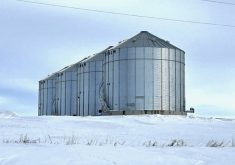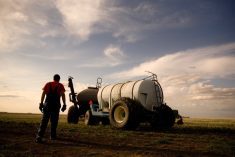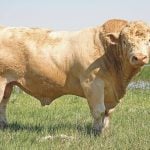Manitoba farm groups were unsurprised by a recent Statistics Canada report into last year’s farm income, which flagged increased farm cash receipt and higher input costs.
After all, Keystone Agricultural Producers director Chuck Fossey noted, it’s almost the end of 2023. Farmers lived those price trends and have seen how things carried into this year.
“We haven’t heard farmers complaining very much,” he said, pointing to several factors KAP hopes to see, like relief on provincial gas taxes and the long awaited passage of Bill C-234, which would exempt fuels for barn heating and grain drying from the carbon tax.
Read Also

Land agreement inked for Cereals Canada GATE facility
James Richardson & Sons, Limited will provide land for the Global Agriculture Technology Exchange (GATE) building in Winnipeg, according to memorandum of understanding with Cereals Canada
Why it matters: Input costs have slipped from last year but farmers are concerned that lower commodity prices may create a profitability problem in 2023.
Canadian farmers brought in more money in 2022 compared to the previous year, but their expenses were also up. That translated to a 7.6 per cent drop in realized net income to $11.8 billion, according to the report.
Realized net income is the difference between cash receipts and operating expenses, minus depreciation, plus income in kind.
Crop receipts were up by 15.2 per cent in 2022, to $53.9 billion, supported by tight supplies in Western Canada after the 2021 drought and strong export demand. Livestock receipts were up by 11.9 per cent in 2022, reaching $34 billion, with gains in all sectors. However, feed costs were also up.
Total farm operating expenses (after rebates) increased by 19.9 per cent in 2022 to $73.3 billion, the largest gain since 1979. In addition to the 20.7 per cent increase in feed expenses, fertilizer costs were up by 54.4 per cent at $11.7 billion, while fuel costs were up by 52.5 per cent on the year at $4.3 billion.
2023
Data for the first three quarters of 2023 shows another increase in farm cash receipts, which in that time total $72.5 billion, up by 7.9 per cent from the same period in 2022.
The ease of drought and return to normal production levels in 2022 led to more marketings this year, pushing crop receipts up by 12.1 per cent though nine months to $41.4 billion, despite a drop in prices.
Canola, wheat and durum led the way. Canola marketings were up by 40.1 per cent, while wheat (excluding durum) was up by 31.1 per cent and durum marketings increased by 73 per cent.
Prices fell 15.5 per cent for canola, 8.9 per cent for wheat (excluding durum) and 17.9 per cent for durum. Those levels were still higher than their five-year average.
J.P. Gervais, chief economist with Farm Credit Canada, said the numbers must be interpreted carefully.
The report only deals with revenues and ignores expenses, so it can paint a misleading picture of farmers’ financial health.
“[It] hides a little bit of the current challenges with margins,” he said.
Growers are starting to feel the pinch of inflation, high interest rates and rising labour costs.
“It is a lot more nuanced, and I would even say fragile than some of the headline numbers would suggest,” said Gervais.
Robert Misko, chair of the Manitoba Crop Alliance, has a similar perspective.
“I think it’s sort of a common story for farming,” he said. “It is a prime example this year how the cost of inputs is way outpacing the price of grain. Even compared to six months ago, (the) price of grain has dropped quite a bit more. And price of inputs is still staying pretty high.”
Misko expressed doubts on how profitable 2023 would be for farmers, given current price levels and an average crop.
“We do everything within our power to either try to improve yields, be more efficient with our use of fertilizer and pesticide and fuel,” he said, pointing to reduced chemical use and increased precision input use through 4R nutrient management.
“You keep tightening your belt anywhere you can and you hope you can keep things going.”
On the livestock side, cattle and supply managed prices were up by 8.9 per cent in the first three quarters of 2023, resulting in a $2.2 billion increase in total livestock receipts to $27.2 billion.
Program payments declined $1.4 billion to $4 billion after hitting record highs in 2022.
Livestock
Cattle receipts were up by $1.8 billion at $9.8 billion in the first three quarters of 2023. That was due to a 28.2 per cent rise in cattle slaughter prices and a 24 per cent rise in international export receipts, caused by strong demand in Canadian and United States markets and higher input costs for producers, according to Statistics Canada.
Supply managed receipts grew 7.2 per cent to $11.2 billion and accounted for just over 40 per cent of total livestock receipts. Dairy receipts were up $312.2 million to $6.4 billion. Both marketings and prices pushed receipts for chickens for meat up $286.4 million to $3.1 billion.
Despite a small increase in marketings, an 11.8 per cent decrease in price led to a 11.2 per cent drop in hog receipts to $4.5 billion.
Those slumping hog receipts also dragged on Manitoba’s numbers, although the province still posted an 8.4 per cent jump in farm receipts, to $7.5 billion.
The hog industry is struggling to balance supply with declining demand in both domestic and export markets.
“China is not what it used to be,” said Gervais, and the anticipated reduction in U.S. hog supply has not materialized, hurting prices.
“Whatever decline in the U.S. herd that has been happening has been offset by some production gains.”
The last quarter
Gervais is curious about what the fourth quarter holds. He expects crop marketing volumes will be down because farmers will be selling a smaller 2023 crop.
However, he thinks prices could rise because he believes markets have been too aggressive in pushing them down. The historically high short positions in futures markets will eventually have to cover themselves.
“I think there is a little bit more upside than downside, frankly,” he said.
Fossey is also taking a wait-and-see approach.
“If we have a poor crop and if grain prices continue to decline, I’m sure a lot of farmers are going to start complaining about not being able to cover the cost,” he said.
– With files from Phil Franz-Warkentin and Sean Pratt
















